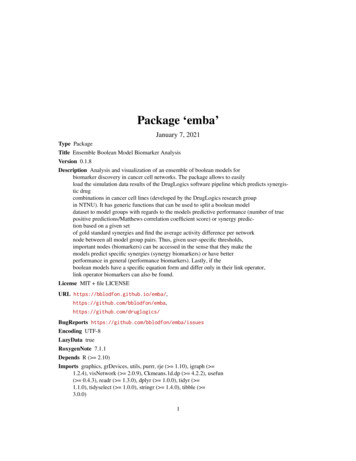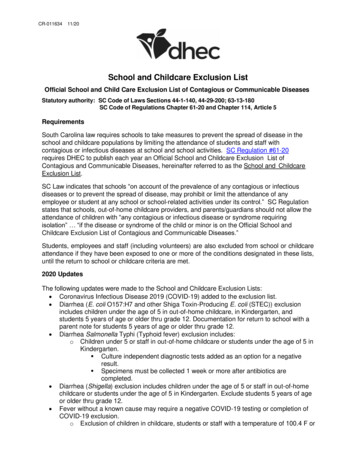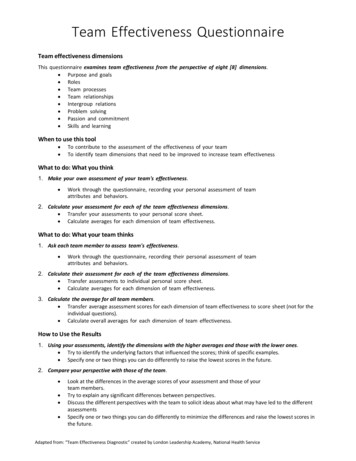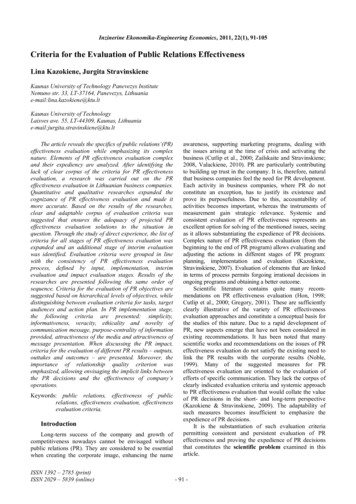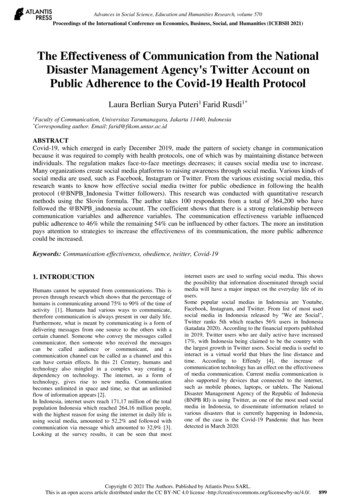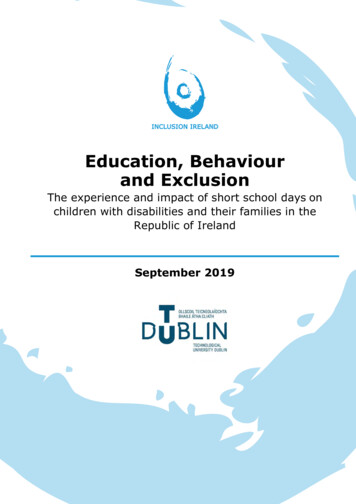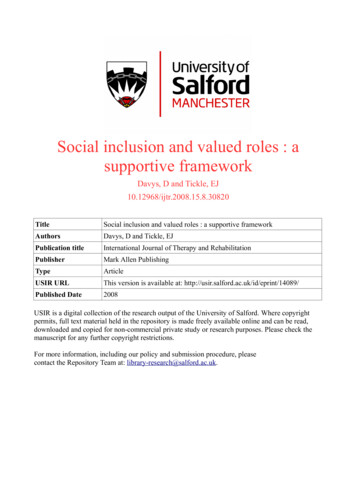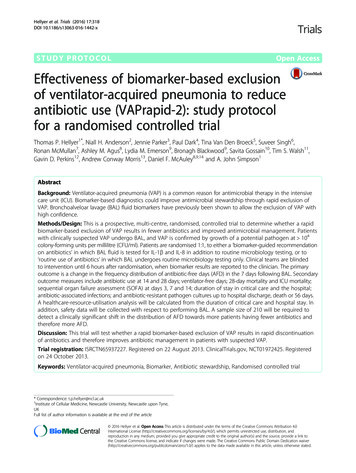
Transcription
Hellyer et al. Trials (2016) 17:318DOI 10.1186/s13063-016-1442-xSTUDY PROTOCOLOpen AccessEffectiveness of biomarker-based exclusionof ventilator-acquired pneumonia to reduceantibiotic use (VAPrapid-2): study protocolfor a randomised controlled trialThomas P. Hellyer1*, Niall H. Anderson2, Jennie Parker3, Paul Dark4, Tina Van Den Broeck5, Suveer Singh6,Ronan McMullan7, Ashley M. Agus8, Lydia M. Emerson9, Bronagh Blackwood9, Savita Gossain10, Tim S. Walsh11,Gavin D. Perkins12, Andrew Conway Morris13, Daniel F. McAuley8,9,14 and A. John Simpson1AbstractBackground: Ventilator-acquired pneumonia (VAP) is a common reason for antimicrobial therapy in the intensivecare unit (ICU). Biomarker-based diagnostics could improve antimicrobial stewardship through rapid exclusion ofVAP. Bronchoalveloar lavage (BAL) fluid biomarkers have previously been shown to allow the exclusion of VAP withhigh confidence.Methods/Design: This is a prospective, multi-centre, randomised, controlled trial to determine whether a rapidbiomarker-based exclusion of VAP results in fewer antibiotics and improved antimicrobial management. Patientswith clinically suspected VAP undergo BAL, and VAP is confirmed by growth of a potential pathogen at 104colony-forming units per millilitre (CFU/ml). Patients are randomised 1:1, to either a ‘biomarker-guided recommendationon antibiotics’ in which BAL fluid is tested for IL-1β and IL-8 in addition to routine microbiology testing, or to‘routine use of antibiotics’ in which BAL undergoes routine microbiology testing only. Clinical teams are blindedto intervention until 6 hours after randomisation, when biomarker results are reported to the clinician. The primaryoutcome is a change in the frequency distribution of antibiotic-free days (AFD) in the 7 days following BAL. Secondaryoutcome measures include antibiotic use at 14 and 28 days; ventilator-free days; 28-day mortality and ICU mortality;sequential organ failure assessment (SOFA) at days 3, 7 and 14; duration of stay in critical care and the hospital;antibiotic-associated infections; and antibiotic-resistant pathogen cultures up to hospital discharge, death or 56 days.A healthcare-resource-utilisation analysis will be calculated from the duration of critical care and hospital stay. Inaddition, safety data will be collected with respect to performing BAL. A sample size of 210 will be required todetect a clinically significant shift in the distribution of AFD towards more patients having fewer antibiotics andtherefore more AFD.Discussion: This trial will test whether a rapid biomarker-based exclusion of VAP results in rapid discontinuationof antibiotics and therefore improves antibiotic management in patients with suspected VAP.Trial registration: ISRCTN65937227. Registered on 22 August 2013. ClinicalTrials.gov, NCT01972425. Registeredon 24 October 2013.Keywords: Ventilator-acquired pneumonia, Biomarker, Antibiotic stewardship, Randomised controlled trial* Correspondence: t.p.hellyer@ncl.ac.uk1Institute of Cellular Medicine, Newcastle University, Newcastle upon Tyne,UKFull list of author information is available at the end of the article 2016 Hellyer et al. Open Access This article is distributed under the terms of the Creative Commons Attribution 4.0International License (http://creativecommons.org/licenses/by/4.0/), which permits unrestricted use, distribution, andreproduction in any medium, provided you give appropriate credit to the original author(s) and the source, provide a link tothe Creative Commons license, and indicate if changes were made. The Creative Commons Public Domain Dedication o/1.0/) applies to the data made available in this article, unless otherwise stated.
Hellyer et al. Trials (2016) 17:318BackgroundPatients admitted to the intensive care unit (ICU)constitute a group vulnerable to healthcare-associatedinfection (HCAI), and consistent with that, antibioticconsumption in the ICU is considerably higher thanin other hospital environments [1]. The growing globalchallenge of antimicrobial-resistance requires improvedantibiotic stewardship. This judgment is, however, challenging in critically ill patients in whom clinical signs ofinfection are non-specific and where the consequencesof missing a treatable infection may be significant.Ventilator-acquired pneumonia (VAP) is a commonICU HCAI and highlights the challenges of antibioticstewardship. Few clinical features have a specificity ofgreater than 60 % [2–4], and infection is confirmedin approximately 40 % of patients with suspectedVAP [5]. The majority of patients with suspectedVAP have antibiotics started at the point of clinicalsuspicion and de-escalation or discontinuation of antibiotics is possible after 2–3 days, when culture information becomes available. During this period, a significantproportion of patients will receive antibiotics that maynot be indicated, and furthermore, if antibiotics are notdiscontinued in light of negative cultures, a full courseof unnecessary antibiotics may be administered.Addressing limitations in diagnostic methods forinfections has the potential to improve antibioticmanagement by expediting the diagnostic process.Biomarkers of infection can act as rapid surrogatemarkers. In a recent multi-centre observational study[5], we validated the findings of a single-centrederivation study [6, 7], showing that bronchoalveolarlavage (BAL) fluid biomarkers could form a reliabletest to exclude VAP. Low concentrations of BAL fluidinterleukin 1-beta (IL-1β) consistently have a strongnegative predictive value (NPV) in both the derivationand validation cohorts. Furthermore, in the validationcohort, a combination of IL-1β and IL-8 could beused as a biomarker test to rule out VAP with highconfidence, with a NPV of 1 and a post-test probability of 0 % (95 % confidence interval 0–9.2 %). Thesebiomarkers are measured by cytometric bead array (CBA),which is a multi-plex, flow cytometric application that canbe performed in approximately 6 hours, offering the potential for a rapid biomarker-based test in the ICU.The aim of this randomised trial is to determine if,in adult patients with suspected VAP, the use of theadditional rule-out biomarker test will improve antibioticmanagement and reduce antimicrobial use in comparisonto decision making based on microbiology results alone.Methods/DesignThis protocol outlines a multi-centre, prospective,controlled trial in which patients with suspected VAPPage 2 of 8are randomised 1:1 to a rapid biomarker-rule-out testin addition to standard care, compared to standardcare alone (clinical judgment plus standard microbiological culture). The primary outcome measure isantibiotic-free days (AFD) in the 7 days followingBAL. This clinical trial adheres to the ConsolidatedStandards of Reporting Trials statement (Fig. 1) [8]and principles of Good Clinical Practice.Study populationParticipants are being recruited from the ICUs of 17National Health Service (NHS) Trusts in the UK, for atotal of 22 ICUs. These ICUs cover a broad case mix ofmedical, surgical and trauma patients, who are representative of current practice across the NHS.Patients with suspected VAP who are at least 18 years ofage, intubated and mechanically ventilated for 48 hours ormore are considered eligible for inclusion in the trial. VAPis suspected based on the presence of a new or worseningchest X-ray or computed tomography (CT) changesconsistent with pneumonia in the context of at least twoof the following: temperature 35 C or 38 C; a whitecell count of 4 109 / L or 11 109 / L; or purulenttracheal secretions [9]. Patients must also be considered suitable for early discontinuation of antibiotics bythe clinical team (i.e. have no extra-pulmonary sourceof infection that mandates the use of continuedantibiotics).Patients are excluded on the basis of previouslypublished criteria [10] that predict poor tolerance of thebronchoscopy and BAL that have been previously applied in our studies [5, 7]. These are: PaO2 8kPa on aFiO2 0.7; positive end-expiratory pressure of 15 cmH2O; peak airway pressure 35 cm H2O; heartrate 140 beats per minute; mean arterial pressure 65 mmHg; bleeding diathesis including platelet count 20 109/L or international normalised ratio (INR) 3;poorly controlled intracranial pressure ( 20 mmHg); orICU consultant deems the procedure not to be safe.Patients may only be randomised to the study once(i.e. they are excluded if they have had previous BAL aspart of the study). Patients are also excluded if assent/consent is declined.Co-enrolment is allowed with observational studies.Co-enrolment with interventional studies is allowedfollowing consideration of any scientific or statisticalinteractions in accordance with current UK recommendations [11].Biomarker assay and laboratory set upThe biomarker assay is performed in six NHS oruniversity laboratories that act as testing ‘hubs’. Participating ICUs had to be within an expected traveltime of 1.5 hours of a hub. BAL fluid samples are
Hellyer et al. Trials (2016) 17:318Page 3 of 8Fig. 1 Consolidated Standards of Reporting Trials (CONSORT) 2010 flow diagramtransported to the laboratory on ice immediately aftersampling and measurement of BAL fluid IL-1β andIL-8 by cytometric bead array is performed with minimal delay on arrival. IL-1β and IL-8 are combined bylogistic regression by the equation, established in thevalidation study [5]: 2:7385 þ 1:4633 log10ð1 þ IL 1βÞ 0:2721 log10ð1 þ IL 8ÞVAP is excluded if the regression output falls below adefined level (-1.7616).
Hellyer et al. Trials (2016) 17:318All equipment, reagents and ongoing maintenanceare supplied by the study’s industry partner, BectonDickinson Biosciences (Franklin Lakes, NJ, USA). Eachhub has been issued an Accuri C6 flow cytometer. Thisis a benchtop flow cytometer designed for its ease ofuse. The biomarker assay and all Accuri standard operating procedures (SOPs) have been designed such thatthey can be carried out by healthcare service laboratorytechnicians with limited flow cytometry experience.Centralised training in the biomarker assay and AccuriC6 was provided by investigators and scientists fromNewcastle University and Becton Dickinson.Accuri quality control tests are performed once a weekby each hub, and these data are monitored by the flowcytometry core facility in Newcastle University. Technicalsupport is provided by the investigators at NewcastleUniversity and by Becton Dickinson.InterventionAll patients enrolled in the trial have suspected VAP andundergo the same clinical procedures of bronchoscopyand BAL. The BAL is performed according to a previously described SOP [5].Patients are randomised to have BAL samples analysedby either the biomarker test in addition to semiquantitative culture (the intervention arm) or semiquantitative cultures alone (the control arm). Theintervention arm is referred to as the ‘biomarker-guidedrecommendation on antibiotics’ group and the controlarm the ‘routine use of antibiotics’ group. All semiquantitative cultures are performed in a NHS or PublicHealth England laboratory and handled by a SOP inaccordance with the UK Standards for MicrobiologicalInvestigation [12]. VAP is confirmed by the widely usedthreshold of growth of a potential pathogen at 104colony-forming units per ml (CFU/ml) [13].Biomarker results are reported to the clinical team bythe technician using a standard script after approximately6 hours. It is anticipated that all patients would have antibiotics started at the point of suspicion of VAP. In theevent of a biomarker result that falls below the cut-offvalue, the clinical team is advised that VAP is excludedwith high confidence and that early discontinuation ofantibiotics is advised. If the biomarker value is abovethe threshold the clinical team is advised that VAPcannot be excluded and that standard care shouldcontinue.Risk to participantsPatients enrolled in this trial are by definition criticallyunwell, and minimising the risk to these patients is ofparamount importance. BAL is an established and widelyused technique for sampling the alveolar regions in ICUpatients [13, 14]. Not only do eligibility criteria excludePage 4 of 8patients who would poorly tolerate a BAL, but patientscan be excluded based on the clinicians’ judgment of therisk profile.The second consideration of risk is around the earlydiscontinuation of antibiotics. The risk exists that antibiotics may be incorrectly discontinued in the face ofundetected infection (i.e. in the setting of a false negativebiomarker test). The validation study demonstrated thatthe threshold for excluding VAP using BAL IL-1β andIL-8 had an NPV of 1 which gives confidence in thetest’s performance, but with a 95 % confidence intervalof 0.92–1.0 false negatives remaining possible. Decisionsaround antibiotic prescribing are not dictated by the trialprotocol, and these ultimately remain at the discretionof the treating clinician. This allows the clinician torestart antibiotics if it is felt they were discontinued inappropriately. This minimises the risk to patients andalso makes the trial more pragmatic, testing its use in‘real life’ clinical practice.Primary outcome and sample sizeThe primary outcome measure is the frequency distribution of AFD in the 7 days following BAL. This intervalwas used as this is the average reported duration ofantibiotic therapy for suspected VAP in UK practice[15]. For the purposes of study design, AFD can beconsidered to be an integer value with patients in one ofeight categories (0–7 AFD). Fewer days of antibiotictreatment will be detected as an increase in the proportion of patients with higher numbers of AFD and fewerpatients having zero AFD. Antimicrobials delivered forprophylaxis will be excluded from analysis.The sample size is based on the frequency distributionof AFD in the 7 days after BAL in our previous validation study. This baseline distribution of AFD showed askew towards patients with suspected VAP having fewor no AFD (with this effect manifest both in those withultimately confirmed VAP and those in whom BALmicrobiology did not confirm VAP). We modelledchanges in the distribution of AFD from baseline to adistribution with more patients having higher numbersof AFD. Table 1 gives examples of the differentfrequency distributions and their effect sizes. We judgeda distribution that equates to effect sizes above 0.07would represent a clinically important difference. Byway of illustration, this would be equivalent to a changefrom a baseline median of 0 AFD (interquartile range0–2.5 AFD) to a median of 1.5 AFD (interquartile range0–3.5 AFD) under biomarker-guided treatment. An effectsize of 0.0797 requires 90 patients per trial arm and allowing for a 15 % drop out, the total sample size is 210. Thisoutcome measure and effect size was presented fornational stakeholder peer review and judged to beappropriate (UK Critical Care Research Forum, July 2013).
Hellyer et al. Trials (2016) 17:318Page 5 of 8Table 1 Models of different frequency distribution of AFD. Standard care distribution is based on data obtained from our validationcohort. The different models demonstrate increasing shifts in the frequency distribution towards more AFD in the sample. Thesedistributions are illustrative, and different proportions in each category could give the same effect size. AFD antibiotic-free daysProportion of AFD (%)01234567N per armEffect sizeStandard Care (from validation study)55101055555Model 1402015555552150.033Model 23520151055551380.052Model 33020151010555960.075Model 42520201010555680.106Figure 2 illustrates the changes in the AFDdistribution between baseline and model 3 fromTable 1.Secondary outcome measuresSecondary outcome measures will include antibioticdays and AFD, expressed as continuous variables, at7, 14 and 28 days; ventilator-free days at 28 days; 28-daymortality and ICU mortality; sequential organ failureassessment (SOFA) score at days 3, 7 and 14; duration oflevel 2 (high dependency unit) care, level 3 (intensive careunit) care and hospital stay; Clostridium difficile andMRSA infections up to hospital discharge, death or56 days; and antibiotic-resistant pathogen cultures up tohospital discharge, death or 56 days. A healthcare-resource-utilisation analysis will be calculated from the duration of level 2 care, level 3 care and hospital stay up todischarge, death or 56 days.Since this is a trial of a complex intervention, aprocess evaluation will be carried out in parallel withthis trial. This will evaluate the process of conductingthe trial and will aim to determine reasons for potential discrepancies in the expected and observed trialoutcome, as well as providing information on the potential implementation of the intervention after trialcompletion. Additional files outline the detailed studyprotocol for the process evaluation (see Additionalfiles 1 and 2).Data collectionData are collected on the day of enrolment (day 0); day3; day 7; day 14; day 28; and date of discharge, death orat 56 days. Clinical data collected include the age,gender, date of admission to the hospital and ICU,reason for admission to the hospital and ICU, functionalcomorbidities index, acute physiology and chronic healthFig. 2 Graphical representation of the shift in distribution in antibiotic-free days (AFD) between baseline and model 3
Hellyer et al. Trials (2016) 17:318evaluation (APACHE) 2 score at admission, SOFA score,time from MV to suspected VAP, and pathogenscultured from BAL.Safety measures will be recorded relative to the bronchoscopy and BAL. These will include SaO2, heart rate,blood pressure and PaO2:FiO2. Biological data will include concentrations of IL-1β and IL-8 in the BAL fluidfor patients who are randomised to the interventionarm.Recruitment process and consentAll patients on the participating ICUs are screened onweekdays for eligibility. Potentially eligible patients arediscussed with the ICU consultant to determine theappropriateness of early discontinuation of antibioticsand whether any other safety concerns are present thatwould exclude the patient.Consent and assent procedures are in keeping with thelegal framework of England, Northern Ireland (MentalCapacity Act, 2005) or Scotland (Adults with Incapacity(Scotland) Act, 2000) for consent/assent of adults withoutcapacity. In England and Northern Ireland informedassent is obtained, where possible, following discussionwith the patient’s next of kin (personal consultee). Wherea personal consultee is unavailable, assent is provided by anominated consultee, usually the ICU consultant, providing they are not also a member of the research team. Incircumstances where the next of kin are unable to attendthe ICU promptly, eliciting their opinion is possible bytelephone to inform nominated assent.In Scotland the patient’s relative or welfare attorneyprovides the informed consent. If the patient’s relative orwelfare attorney is unable to attend the ICU, consentmay be provided in a telephone conversation, providinga second member of staff witnesses the discussion.Patients who recover capacity will be approached toprovide retrospective informed consent. The decision asto whether that patient has regained capacity will residewith the treating team. The patient will be given sufficient time to consider the trial information before providing their consent to continued trial involvement.Randomisation and blindingOnce consent/assent is obtained, the clinical teaminforms the laboratory technician who will perform thebiomarker test, and the technician then initiates randomisation through the Newcastle Clinical Trials Unit(NCTU). Randomisation is performed using a webbased randomisation service. Patients are randomised tothe intervention arm or control arm in a 1:1 ratio bypermuted blocks of variable length and stratified by site.The randomisation service generates either an instruction that the patient is randomised to ‘biomarker-guidedrecommendation on antibiotics: analyse sample on arrival’Page 6 of 8or to ‘routine use of antibiotics: do not analyse sampleon arrival’. This message is emailed to the technician.The clinical team is initially blinded to the trial armsince all trial procedures are performed in all participants. Unblinding occurs when the biomarker resultis called back to the clinical team after approximately6 hours. To ensure consistency in unblinding, afterthis period, the clinical team are also informed if thepatient was randomised to the control arm. The technician contacts the clinical team with the resultsaccording to local arrangements, which include contacting the on-call ICU consultant, ICU resident orthe local principal investigator.Statistical analysisBaseline clinical data will be compared between trialarms for balance using graphical and summary statisticsappropriate for the data type of each variable. No formaltests of equality will be carried out. The primary outcome measure will be analysed by a chi-squared test ona 2 8 table of study arm versus AFD categories.Secondary outcome measures will be analysed by fittingappropriate generalised linear models with interventionand centre as covariates. Link functions will be determined by the type of outcome variable. A sub-groupanalysis for patients with trauma or head injury will beincluded as will a sub-group analysis based on clinicianassessment of likelihood of VAP. Data analysis will beperformed on an intention-to-treat basis, although otherexploratory analyses including per-protocol analysis willbe considered. A per-protocol analysis will be performed excluding patients who were randomised tothe biomarker-guided recommendation on antibioticsarm, but who had a technical issue with the assay andtherefore defaulted to standard care.A within-trial cost analysis will be undertaken to assessthe hospital resource use from the point of randomisationuntil hospital discharge or death, whichever occurs first,for a maximum of 56 days. Patient-level hospital resourceuse will be estimated from length of ICU stay and lengthof hospital stay. Multiple regression analyses will beperformed to examine patient factors, which are potentially associated with costs. The robustness of the results will be evaluated using sensitivity analyses.Monitoring and adverse event reportingA Data Monitoring and Ethics Committee will haveoversight of the trial. This is an independent body thathas oversight of safety data. They will make recommendations to the sponsor as to whether the trial shouldprogress, be modified or terminated.NCTU will monitor adherence to the trial protocoland completeness of the data collection. Adverse events(AE) and serious adverse events (SAE) that occur within
Hellyer et al. Trials (2016) 17:3182 hours of BAL are reported to NCTU. Site investigatorsare able to report an AE/SAE outside of this period ifthey feel an AE/SAE is related to the study.Page 7 of 8group. It also represents a challenging and complex trialof novel diagnostics in a difficult clinical space. Theprocess of conducting this trial will provide valuableinformation to inform future trials.Trial approvals, registration and statusEthics approval for this trial has been granted by theNational Research Ethics Service (England and NorthernIreland, Camberwell St Giles Committee, 13/LO/0651)and by the Scotland A Research Ethics Committee (13/SS/0074). Local research governance approval has beengranted in the 17 NHS Trusts in which the trial is conducted: The Newcastle Upon Tyne NHS FoundationTrust; City Hospitals Sunderland NHS FoundationTrust; Heart of England NHS Foundation Trust; SalfordRoyal NHS Foundation Trust; Chelsea and WestminsterNHS Foundation Trust; Lancashire Teaching HospitalsNHS Foundation Trust; Belfast Health and Social CareTrust; NHS Lothian; Countess of Chester NHS Foundation Trust; Northumbria Healthcare NHS FoundationTrust; University Hospitals Coventry and WarwickshireNHS Trust; Royal Liverpool and Broadgreen UniversityHospitals NHS Trust; Gateshead Health NHS FoundationTrust; Sandwell and West Birmingham Hospitals NHSTrusts; The Dudley Group of Hospitals NHS FoundationTrust; Central Manchester Hospitals NHS FoundationTrust; and South Tees Hospitals NHS Foundation Trust.The trial is registered on the ISRCTN registry (65937227)and on ClinicalTrials.gov (NCT01972425).DiscussionLimitations in diagnostic techniques to correctly rule-inor rule-out infections results in many patients receivingunnecessary antibiotics. Successfully validating the useof BAL fluid IL-1β and IL-8 to exclude VAP has been asignificant step forward for developing diagnostics inthis area [5]. A rapid rule-out of VAP should allow fordiscontinuation of antibiotics on the day of suspicion ofVAP and therefore improve antibiotic management. Thisrandomised controlled trial aims to determine the clinicalutility of a rapid biomarker-based test by measuringthe antibiotic use, which is expressed as AFD, in the7 days that follow BAL.Few biomarkers are used in the ICU to guide antibiotic management, and none specifically for VAP. Dueto the novelty of the biomarker and the conduct of thistrial in a complex clinical environment, regular education and reinforcement of the trial protocol is necessarywith participating sites. Furthermore, the trial methodology accommodates the complexity of the interventionby including elements such as the process evaluation.This trial represents a potentially important stepforward for novel diagnostics in the ICU. If effective inits primary outcome it could result in an important improvement in antimicrobial stewardship in this patientTrial statusThe trial is currently active in all participating sites. Thefirst patient was recruited in December 2013, and thetrial is due to complete in 2016.Additional filesAdditional file 1: Process evaluation of the implementation and deliveryof the VAPrapid-2 trial. Process evaluation protocol. (DOCX 33.9 kb)Additional file 2: VAPrapid-2 Logic Model. (PDF 87 kb)AbbreviationsAE, adverse event; AFD, antibiotic-free days; APACHE, acute physiology andchronic health evaluation; BAL, bronchoalveolar lavage; CBA, cytometric beadarray; CFU, colony-forming units; CT, computed tomography; HCAI, healthcareassociated infection; ICU, intensive care unit; IL-1β, interleukin-1 beta; IL-8,interleukin-8; MRSA, methicillin-resistant Staphylococcus aureus; NCTU, NewcastleClinical Trials Unit; NHS, National Health Service; NPV, negative predictive value;SAE, serious adverse event; SOFA, sequential organ failure assessment; SOP,standard operating procedure; VAP, ventilator-acquired pneumoniaAcknowledgementsThis trial is supported by the Department of Health and Wellcome Trustthrough the Health Innovation Challenge Fund (www.hicfund.org.uk).Becton Dickinson Biosciences is a co-applicant to the HICF project proposaland provides reagents and equipment for the biomarker analysis.We would like to thank the Newcastle University flow cytometry core facilityfor their technical support in planning and training and in the use of theSOPs for the biomarker assay.Authors’ contributionsAJS conceived, designed and obtained funding for the trial. AJS contributesto the management of the trial and drafted the manuscript. ACMcontributed to the design of the trial and application for funding. TSWcontributed to the design of the study and funding application. DFMcAcontributed to the design of the study and the funding application. RMcMcontributed to the design of the trial, funding application and planning themicrobiological elements of the trial. GDP contributed to the trial designand funding application. TPH contributed to the trial design and to finalisingthe trial protocol; obtained regulatory approval; contributed to the statisticaldesign; and contributed to the biomarker assay protocol development,management of the trial and drafting the manuscript. JP contributed tofinalising the trial protocol, obtaining regulatory approvals and managingthe trial. NHA led the statistical design of the study. PD contributed to thetrial design. SS contributed to the trial design. AA provided expertise for healtheconomic evaluation. LME contributed to the design of the process evaluation.BB contributed to the design of the process evaluation. SG contributedto the microbiological elements of the study. TvDB contributed to thedevelopment of the biomarker assay protocol. All authors contributed toand reviewed the final manuscript. All authors read and approved thefinal manuscript.Authors’ informationTPH – Specialty Registrar Anaesthetics, Sunderland Royal Hospital,Sunderland, UK. PhD student, Institute of Cellular medicine, NewcastleUniversity, Newcastle, UK.NHA – Senior Lecturer in Medical Statistics, Centre for Population HealthSciences, University of Edinburgh, Edinburgh, UK.JP – Trial Manager, Newcastle Clinical Trials Unit, Newcastle University,Newcastle upon Tyne, UK.
Hellyer et al. Trials (2016) 17:318PD – Reader and Consultant in Critical Care Medicine, Institute of Inflammationand Repair, University of Manchester, Manchester Academic Health SciencesCentre & Intensive Care Unit, Salford Royal NHS Foundation Trust, GreaterManchester, UK.TvDB – Scientist, Becton Dickinson Biosciences, Erembodegem (Aalst), Belgium.SS – Honorary Clinical Senior Lecturer, Imperial College School of Medicine,London. Consultant and respiratory medicine and critical care, Chelsea andWestminster Hospital, Imperial College London, London, UK.RMcM – Senior Lecturer and Consultant Microbiologist, Department ofMedical Microbiology, Kelvin Building, The Royal Hospitals, Belfast, UK.AA – Health Economist, Northern Ireland Clinical Trials Unit, Elliot DynesBuilding, The Royal Hospitals, Belfast.LME – MRC-HTMR Research Fellow, Centre for Experimental Medicine,Queen’s University Belfast, Belfast, UK.BB – Senior Lecturer, Centre for Experimental Medicine, Queen’s UniversityBelfast, Belfast, UK.SG – Consultant
hub has been issued an Accuri C6 flow cytometer. This is a benchtop flow cytometer designed for its ease of use. The biomarker assay and all Accuri standard oper-ating procedures (SOPs) have been designed such that they can be carried out by healthcare service laboratory technicians with limited flow cytometry experience.
